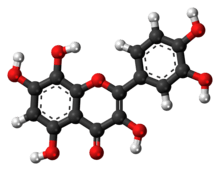Gossypetin
Gossypetin, also known as 3,5,7,8,3',4'-hexahydroxyflavone, is a flavonol, a type of flavonoid. It has been isolated from the flowers and the calyx of Hibiscus sabdariffa (roselle) and exhibits a strong antibacterial activity.[1][2] The compound has also been found to act as an antagonist of TrkB.[3] Recently it was shown that gossypetin has radioprotective activity.
 | |
 | |
| Names | |
|---|---|
| IUPAC name
2-(3,4-dihydroxyphenyl)-3,5,7,8-tetrahydroxychromen-4-one | |
| Other names
Articulatidin Equisporol 3,3',4',5,7,8-Hexahydroxyflavone 3,5,7,8,3',4'-Hexahydroxyflavone | |
| Identifiers | |
3D model (JSmol) |
|
| ChEBI | |
| ChEMBL | |
| ChemSpider | |
PubChem CID |
|
| UNII | |
CompTox Dashboard (EPA) |
|
| |
| |
| Properties | |
| C15H10O8 | |
| Molar mass | 318.23 g/mol |
Except where otherwise noted, data are given for materials in their standard state (at 25 °C [77 °F], 100 kPa). | |
| Infobox references | |
The enzyme 8-hydroxyquercetin 8-O-methyltransferase uses S-adenosyl methionine and gossypetin to produce S-adenosylhomocysteine and 3,5,7,3',4'-pentahydroxy-8-methoxyflavone.
References
- Antibacterial activity of gossypetin isolated from hibiscus sabdariffa
- Amitava Khan, Krishnendu Manna, Chinchubose, Mahuya Sinha, Dipesh Kr Das, Swaraj Bandhu Kesh, Anindita Chakrabarty, Asoke Banerji & Sanjit Dey: Gossypetin, a naturally occurring hexahydroxy flavones ameliorates gamma radiation mediated DNA damage International Journal of Radiation Biology (2013):89(11): 965-975.
- Obianyo, Obiamaka; Ye, Keqiang (2013). "Novel small molecule activators of the Trk family of receptor tyrosine kinases". Biochimica et Biophysica Acta (BBA) - Proteins and Proteomics. 1834 (10): 2213–2218. doi:10.1016/j.bbapap.2012.08.021. ISSN 1570-9639. PMC 3602283. PMID 22982231.
This article is issued from Wikipedia. The text is licensed under Creative Commons - Attribution - Sharealike. Additional terms may apply for the media files.